《1 Introduction》
1 Introduction
The current state of the global energy market is consistent with the development of the digital era. An international consensus calls for expedited energy transition; China is currently modernizing its power system. China is displaying its commitment and resolution to promote the global transition to a low-carbon and environmentally friendly economy by actively implementing programs to satisfy carbon peaking and carbon neutrality targets [1]. Building a new power system with new energies as its primary fuel is a significant national objective and key industry development trend. It is crucial to advance the theoretical research on new power systems and drive the transformation and growth of electric power companies [2].
China’s digitalized power grid construction is still in its early stages, and research on the role of the new generation of information and communication technology (ICT) in developing the power grid technology, application scenarios, and other areas is still insufficient. The corresponding system research framework needs to be established.
The “transparent power grid” concept was proposed by Li Licheng’s research team, concentrating on integrating ICT and power grid applications. This concept can serve as a fundamental guide for the digital creation of new power systems and the future growth of the power grid. This study aims to discuss the theoretical framework and critical technologies of transparent power grids systematically, reflect on the new macro situation, and provide the theoretical foundation for constructing transparent power grids in China. Specifically, it examines the concept of energy ecosystem, business needs, vision and characteristics, and development blueprint of transparent power grids. Here, the critical science and technology system of transparent power grids is proposed, the multi-level critical technologies involved in the technology system and basic equipment are analyzed, and suggestions for the development of transparent power grids in China are provided.
《2 Energy ecosystem and business needs of the transparent power grid》
2 Energy ecosystem and business needs of the transparent power grid
《2.1 Concept of transparent power grid energy ecosystem》
2.1 Concept of transparent power grid energy ecosystem
Under the trend of energy transformation, the transparent power grid is a new development form that integrates the power grid with the new-generation ICT represented by the Internet, incorporating the current major technological progress and industrial development needs. It integrates and innovates the existing dispersed systems and platforms, strengthens the sensing and control capability of the entire chain of power supply, power grid, loads, and energy storage, and significantly improves the construction, operation and maintenance (O&M), and management of the power system through the use of the Internet concept, big data, cloud computing, Internet of Things (IoT), mobile Internet, artificial intelligence (AI), blockchain, and other advanced technologies. This approach breaks the business barriers of operation control and operation management, grasps the massive end-user and operation data, realizes the transparent control of energy, business, and data flows, and then gives full play to the optimal allocation of resources to form the power market-driven electric energy ecosystem shown in Fig. 1.
《2.2 Business needs for transparent power grid》
2.2 Business needs for transparent power grid
2.2.1 General business upgrade and optimization
The first component is the comprehensive perception of the power grid status. An intelligent O&M of the transparent power grid will extensively use the power grid data gathered by small smart and wireless sensors to build a large-scale sensing network. Edge computing and adaptive control algorithms will be developed based on small intelligent sensing control and new-generation communication technologies. They will be combined with machine learning and other AI algorithms to quickly summarize, analyze, and process massive amounts of data. It will support fault diagnosis, operation, and maintenance decisions and improve the reliability of the system power supply.
The second component is the digital operation control platform. To meet the needs of the rapidly developing power grid management, an enterprise-level power grid management platform should be built based on the transparent power grid cloud platform and the gradual cloudification and micro-service transformation of existing asset management systems and geographic information systems. This platform unifies asset and value management, integrates power grid planning, design, construction, equipment supply, and other enterprise resources, and builds a cooperative ecology. It breaks the barriers of different information systems, promotes the access of various business data to the big data sharing platform, and strengthens the horizontal synergy of all grid businesses and the vertical coherence at all levels.
The third component is the intelligent decision-making of power grid operation. It combines the domain knowledge with machine learning methods to achieve model-driven and data-driven complementarity and deeply mine the potential values of massive data from large-scale sensor networks. Based on the transparent power grid cloud platform, with a “model plus data” hybrid drive mode as the pillar, a unified management of the data resources of the entire network is realized. Thus, it takes advantage of the transparent grid’s ubiquitous visible, knowable, and controllable data, and provides intelligent decision support for efficient, economical, safe, and stable operation of the power grid.
《Fig. 1》
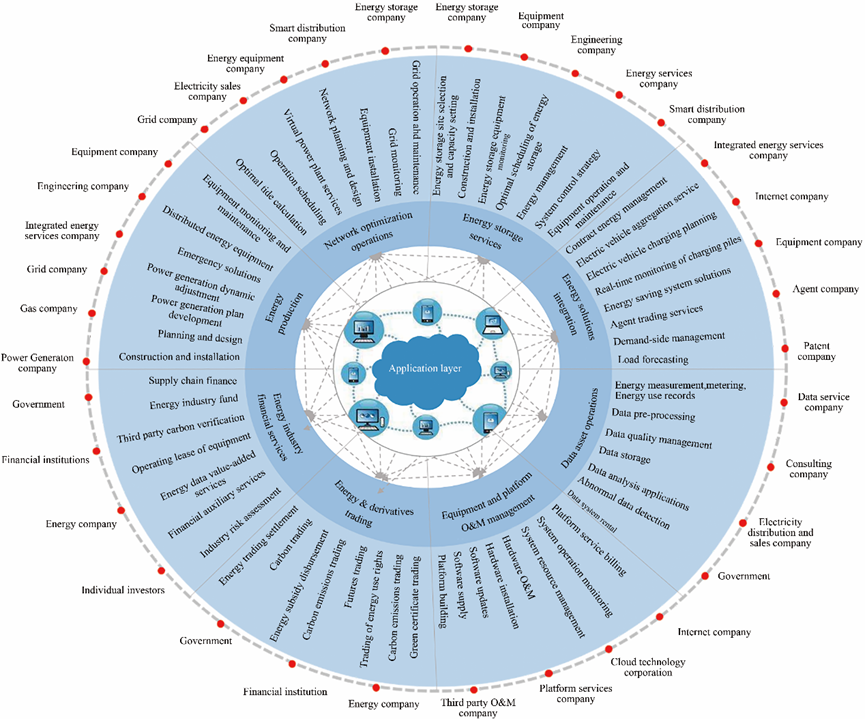
Fig. 1. Energy ecosystem closely related to the transparent power grid.
2.2.2 Emerging business development and management
The first aspect to consider is the power trading and electricity saving business. The 13th Five-Year Plan for Electricity Development (2016–2020) proposes establishing and improving the electricity market system and a standard and unified technical support system for electricity market transactions. Therefore, improving the transparency of transactions is a key task in constructing the electricity market, which is mainly reflected in the following two aspects: (1) Electricity trading information sharing under the premise of guaranteeing information security. Currently, provinces are facing the problem of insufficient articulation and coordination between power trading systems, and the sharing of trading information and data interaction is greatly hindered. This results in inadequate transparency of public information such as power dispatching operation data, market information, and market transactions. Transparent power grids can predict electricity consumption behaviors and optimize power dispatch through the transparency of customers’ electricity consumption behaviors, realizing ubiquitous visibility and knowledge of the power grid data information. They can also provide a panoramic display of the value dimensions of the industry chain, such as time, space, and business, and drive the sharing of transaction information, data interaction, and the expansion of power trading business. Optimized allocation of resources needs to be promoted to assist in improving the power trading management capability. (2) Data integration of power-saving business under the premise of guaranteeing information security. The power-saving business refers to energy-saving service companies providing customers with a series of services, such as energy consumption analysis, energy-saving solution design, energy-saving equipment customization, installation and commissioning, and energy-saving effect evaluation, to recover investment and make profits from the energy-saving benefits obtained by customers. For transparent power grids, the development of the power saving business will solve the problems faced by users of opaque power consumption data and lack of guidance for power saving. It subdivides into power consumption groups according to users’ power consumption characteristics and forms optimal power-saving strategies through correlation analysis of multi-source data, driving the power saving process to be visible, knowable, and controllable.
Second, the power demand-side response, which mainly includes orderly power consumption, energy efficiency management, and load management, reasonably allocates power resources by administrative, economic, and technical means to ensure the balance of supply and demand and minimize power shortage losses under the situation of significant conflicts between power supply and demand. The transparent power grid relies on small and micro intelligent sensors for extensive collection and efficient processing of power data to improve the accuracy and speed of load control for power demand-side response. This makes the demand-side load resources widely involved in system backup, peak regulation, frequency regulation, and other services.
The third aspect is the digital energy ecology construction. Comprehensive sensing and control of power grid status and information will generate massive data. Thus, digital transformation of the power grid and digital energy ecology construction is the way to realize safe and efficient use of massive data. (1) Digital government is a new model of government operation that features business digitalization. The transparent power grid will develop information and service interface standards and specifications based on the interface needs of the digital government, digital power grid, and stakeholders. With the help of the power grid management and customer service platforms, the transparent power grid will share information and services with the digital government, digital power grid, and stakeholders. (2) Power financial services (power insurance) refine the granularity of underwriting claims through power grid asset classification, and realize the classified risk management of grid assets. It is necessary to study the risk of grid operation continuously and develop insurance products for the entire process of construction, operation, and decommissioning of grid assets to achieve comprehensive risk coverage. Professional power insurance service capacities and teams need to be built to provide refined, specialized, and differentiated services for power industry customers.
《3 Vision, characteristics, and development blueprint of the transparent power grid》
3 Vision, characteristics, and development blueprint of the transparent power grid
《3.1 Vision of the transparent power grid》
3.1 Vision of the transparent power grid
In terms of electric energy production, the transparent power grid can sense load demand in real time to predict loads intelligently. It can also conduct coordinated and optimized power supply and load scheduling while considering both renewable energy consumption and system operation costs to improve the energy utilization efficiency. It is necessary to improve the efficiency of new energy sources in an active manner to upgrade them from being supplementary to alternative, or even to become the main energy sources, thus providing solid support for constructing a clean, low-carbon, safe, and efficient energy system.
In terms of power grid operation, intelligent electrical equipment is used as a carrier to achieve flexible and fast control of the power grid, and AI and modern control technologies are used as a means to ensure the intelligent operation of the power grid. The efficiency and stability of the grid are significantly improved to lead the intelligent power grid to an advanced stage. Power grid enterprises are encouraged to promote the integration of business and digital technologies for users, provide comprehensive digital business services, and eventually achieve efficient digitalization of the entire business.
In terms of energy storage services, large-scale distributed applications of energy storage devices are implemented to improve the grid security and operational efficiency when large-scale renewable energy is connected, considering the rapid response on the demand side and the improvement of user economic benefits.
In terms of power-consumption-side services, a transparent-grid-based mode that integrates the production and sales of distributed and micro energy sources can transform the energy supply mode from centralized to distributed. This mode monitors and senses the users’ energy consumption equipment information and coordinates and controls the users’ distributed power supplies, electric energy storage equipment, and controllable loads to achieve the balance of electric energy supply and demand.
In terms of data asset operation, the deep transparency of data information of all equipment and all types of states in the transparent power grid is realized and relevant historical information and online information can be freely accessed to predict future data information reasonably.
In terms of equipment and platform O&M management, based on the large-scale application of small and micro smart and wireless sensors, a ubiquitous sensor network is constructed to form the basic ability to monitor the power grid equipment and measure the large-scale and wide-area big data of the power grid.
In terms of energy and derivatives trading, the transparency of the power grid supports the free choice and flexible trading of power supply, power grid, load, and energy storage participants, making the marginal cost of power production, transmission, conversion, consumption, and trading approach zero.
In the energy industry financial services, the transparent power grid is important to build the energy ecosystem and plays important roles as “pipeline” and “platform” in the energy transformation.
《3.2 Basic features of the transparent power grid》
3.2 Basic features of the transparent power grid
3.2.1 Comprehensive perception of power grid status
The transparent power grid can (1) perform online real-time perception of equipment health and environmental status to achieve power grid status monitoring, situational awareness, and intelligent O&M; (2) conduct real-time online sensing of power grid transmission capacity and power quality to realize grid security risk assessment, economical operation optimization, and intelligent decision dispatching; (3) carry out real-time publication of transmission and distribution prices, prices of various power markets and ancillary services, and trading process/results to facilitate the free choice of power supply, power grid, load, and energy storage participants and real-time monitoring of the trading process by market regulators and participants.
3.2.2 Transparent transmission of information
Information sharing is realized through strict authority allocation to build a database of energy network topology relationships. The big data analysis technology is adopted to identify topological information about energy transmission networks and keep the state transparent. An application deployment model that is multi-agency and multi-level and considers independence is planned, and unified data management and information integration is implemented.
3.2.3 Transparent business
A distributed control and optimization framework is built to drive multiple entities to cooperate, and system-wide operating goals are configured to complete the interconnection between various businesses and achieve business transparency.
3.2.4 Transparent operation status
The system security analysis theory and big data analysis technology are utilized to process information such as transmission capacity and energy supply quality of each energy system in real time and fully acquire the equipment information, operation data, and daily data of the power grid.
3.2.5 Broad participation
Through ubiquitous interconnection and deep sensing, various resources are brought together to participate in the operation and regulation of the power system, promoting the synergistic interaction of “power supply, power grid, loads, and energy storage” and shifting the mode from “power supply follows load changes” to “interaction between power supply and loads.”
3.2.6 Free storage and access to power grid data
Free (unlimited/massive) data storage and access to the grid are achieved through small and smart sensors, sensing networks, and software platforms, as well as communication, big data, cloud computing, edge computing, and AI technologies.
3.2.7 Transparency of energy market trading status
The capacity, quality, and price of the power supply available at each node of the network and at each time as well as the price of various auxiliary services become transparent and market-oriented, realizing real-time access to energy market information. Thus, the market profitability mechanism is mature, and the energy trading process is fair, just, and open.
《3.3 Blueprint for transparent power grid development》
3.3 Blueprint for transparent power grid development
3.3.1 Promote clean and low-carbon energy use
In terms of promoting supply-side energy reforms, building transparent power grids will actively support the consumption of clean energy and encourage deeper reforms of the power market, which is conducive to improving the rules of the power market related to renewable energies. The guarantee mechanism should be improved for natural gas power generation and renewable energy power consumption to stimulate investment in related flexible resources. The energy supply should coordinate with power planning to optimize power system dispatching operations.
In the optimization of the energy supply structure, the construction of a transparent power grid will follow the main line of securing the energy supply and promoting clean and low-carbon energy, fostering the clean and efficient use of coal, and strictly controlling the total amount of coal consumption. This expands the scale of natural gas power generation and improves its level of utilization, thus accelerating the development of non-fossil energy sources and increasing their proportion in the electricity consumption. It actively seeks clean energy supply from outside the region to meet the demand for new energy and electricity and improves the efficiency of electricity use in key areas and industries to ensure the efficient use of energy. It also improves the electrification level of terminal energy use, bringing the environmental benefits of energy development deep into the terminal level.
3.3.2 Guarantee the safety and efficiency of electricity consumption
The transparent power grid improves the main power grid structure, builds outer ring channels outside, builds soft and straight “back-to-back” channels inside, and interconnects the sub-district groups with reasonable stratification and clear inter-district liaison to eliminate power grid short-circuit current overload, large-scale tidal current transfer, AC–DC mutual influence, and other power grid operation risks. It scientifically builds the main power grid structure to ensure sufficient capacity, clear structure, efficient operation, and controllable accidents. This enhances the level of interconnection and interoperability of power infrastructure, improving the power security and optimal allocation of power resources.
The digital operation and control platform of a transparent power grid realizes the construction of an energy anti-risk system, which improves the anti-risk capacity of the power system providing a sound energy emergency linkage and collaboration mechanism to improve the anti-risk capacity of the energy system.
Network security construction is an important link in the construction of transparent power grid security and achieves policy coordination, formulation of norms and standards, and continuous improvement in information security services.
It strengthens the cooperation and integration of resources, technologies, and trade in the energy sector, and builds a diversified energy supply system. It emphasizes the development of transparent power grid security, strengthens the energy “storage and transportation” network, improves the energy emergency security mechanism, enhances the anti-risk capability of the energy system, and builds the cornerstone of energy security.
It coordinates the relationship of energy development between regions, promotes the synergistic development of energy and manufacturing, transportation, marine, information, and other industries, and promotes the optimal allocation of resources and high-quality regional development through the coordinated development and efficient operation of “power supply, power grid, load, and energy storage.”
Energy conservation and high-efficiency and low-carbon utilization should be combined to promote an energy consumption revolution, promote regional comprehensive energy utilization, restrain unreasonable energy consumption, and improve energy utilization efficiency. Through transparent power grid quality improvement and efficiency, a new situation of energy use with conservation, efficiency, and a green and low-carbon economy should be created.
3.3.3 Innovate the development of the power industry
The transparent power grid promotes the development of the intelligent power transmission and distribution industry. It also promotes the integration of big data, cloud computing, IoT, mobile Internet, AI, blockchain, and other information and communication technologies with the power system automation industry, implements intelligent upgrading and localized manufacturing of core equipment, and expands flexible DC transmission and distribution equipment, smart grid, and customer-side equipment manufacturing. The widely used active distribution network, the “plug and play” power electronic grid-connected equipment, meets the demand for flexible and friendly access to distributed power sources.
The existing foundation is exploited and integrated to carry out transparent power grid construction and promote the deep integration of smart cities, the Internet, information and communication technologies with energy systems and energy markets. This leads to new technologies, new models, and new business models for the energy Internet to promote the transformation and upgrading of the energy industry. Through the intelligence of energy production and operation, the deep integration of electrification and information technology in energy consumption is encouraged, establishing an open and mutual trust energy market, and building an intelligent energy system.
The transparent power grid maintains an investment in energy science and technology innovation, promotes the cooperation of “government, industry, academia, and research” in the energy field with the construction of intelligent energy on the energy Internet, and cultivates an innovative industrial ecosystem of intelligent energy. It plays the leading and regulating role of government planning, enhances the main position of enterprises in energy science and technology innovation, and builds the highland of independent innovation in the energy industry and advanced manufacturing industrial base.
It reforms the energy management system mechanism and promotes the integrated development of the energy market, as well as the free flow and efficient allocation of various energy factors. It innovates mechanisms for energy coordination and regulation, investment and financing, price formation and market transaction models, and breaks the role of the old energy system and mechanisms in impeding high-quality development.
《4 Key science and technology system of the transparent power grid》
4 Key science and technology system of the transparent power grid
《4.1 Incremental technological innovation elements of the transparent power grid》
4.1 Incremental technological innovation elements of the transparent power grid
The extensive access to “wind, photovoltaic, storage” and smart terminals has significantly increased the complexity and uncertainty of the power system. To adapt to the system evolution, the power grid architecture should be upgraded simultaneously. The main feature of the transparent power grid is the full lifecycle transparency and visibility of the whole power grid data, which is a suitable technical solution, while the theoretical methods and key technical systems for traditional power systems are difficult to follow.
The development of a transparent power grid relies on the extensive configuration of small and smart sensors, along with the perception, transmission, processing, and application system of information flow. This obviously requires many theories and scientific methods to provide solid support, as follows: (1) network theory and methods, represented by IoT theory, which leads to device diversification and interconnection of everything in the transparent power grid; (2) data science theory and methods, which support the realization of the whole life cycle of massive data in the transparent power grid; (3) AI theory and methods, which adapt to the actual power grid work that involves a complex system intelligent operation and massive data intelligent mining; (4) complex system science theory, power system theory and methods, and management science theories and methods, which are important basic supports for the reliable operation of the new scenario of the transparent power grid.
The above theories and scientific methods will support the breakthrough of the key technology system of the transparent power grid, which can be built from the following four levels: (1) Perception layer: Multi-parametric intelligent micro and nano sensing is the foundation of the transparent power grid and the source of “transparent” data construction. (2) Communication layer: An efficient, reliable, and secure communication network is the transmission channel of massive data and supports “transparent” data transmission. (3) Platform layer: The intelligent terminal control platform and the data platform will provide a complete management mechanism for the data. The digital twin modeling and fusion platform, an important derivative of the transparent power grid, is the carrier of the “transparent” network function. (4) Application layer: AI technologies developed for practical business needs and the introduction of behavioral science and mathematical optimization theory for solving practical management problems in the new scenario of the transparent power grid.
It is worth pointing out that the series of key technologies of the traditional grid still have value but need to be upgraded for the new scenario of the transparent grid, as shown in Fig. 2.
《4.2 Theories and scientific methods involved in transparent power grids》
4.2 Theories and scientific methods involved in transparent power grids
4.2.1 Theory of complex systems science
The complex network theory [3,4], socio-physical information system theory, and multi-intelligent body system theory are the main complex systems science theories related to developing and constructing transparent power grids. (1) The complex network theory aims to solve the problem of describing the relationship between system objects by probability, which can reflect the uncertainty of the system, provide basic tools for analysis and decision-making, and optimize the control of complex network systems. This combined with the classical power system theory can bring into play the advantages of their respective applications. (2) The theory of the socio-physical information system aims to solve the problems of system operation level and performance improvement, whereby the grid can realize the functions of computing, communication, precise control, remote collaboration, and autonomy, thus achieving the coordination and unification of the energy, talent, and information flows in the power grid ecology. (3) The multi-intelligence body theory aims to solve the morphological problems of power system organization and decision-making and split the large and complex power grid system into smaller scale, intercommunication, easy coordination, and management systems. Thus, distributed computing, distributed prediction, monitoring, and diagnosis, distributed intelligent decision-making, and coordinated expert systems can be realized.
《Fig. 2》
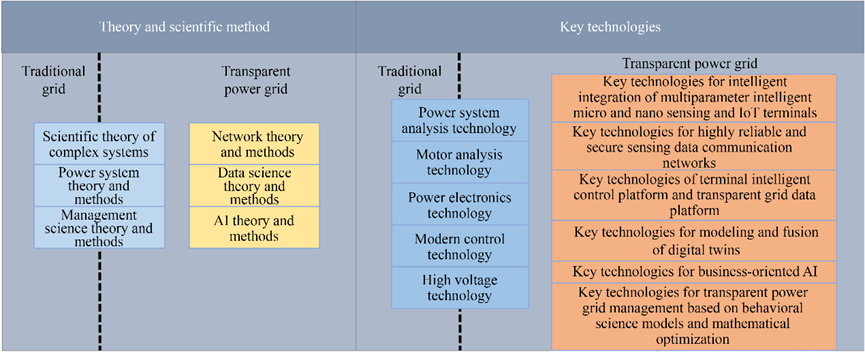
Fig. 2. Comparison of key science and technology systems for two types of power grids.
4.2.2 Power System Theory and Methods
The main power system theories and methods related to developing and constructing transparent power grids are the modern control theory [5] and renewable energy system analysis methods. (1) The modern control theory aims to solve the relevant fundamental problems in multivariable, nonlinear, and time-varying systems, to realize the intelligent operation of power grids, and to improve the efficiency and stability of power grid operation using modern control technology. (2) The analysis method of the renewable energy system aims to solve the multi-energy distributed optimization problem [6]. Because of the uncertainty and volatility of the grid after a large amount of renewable energy is connected, it is necessary to model energy hubs and multi-energy flow networks, establish distributed operation and control systems, use algorithms to optimize operation strategies to achieve coordinated multi-energy operation and distributed cooperative regulation, and finally realize multi-energy cooperation.
4.2.3 Network theory and methods
Network theories and methods for developing and constructing transparent power grids mainly include the network value theory, IoT theory [7], and network analysis methods. (1) Network value theory provides a measurable method of transparent power grid value. With the promotion and application of small and micro sensors, the physical state of power equipment and environmental information become nodes in the power network. This supports the realization of a comprehensive perception of the power grid state, online real-time intelligent perception of equipment health, and awareness of the environmental condition, according to which fault diagnosis and O&M decisions are formed to improve system power supply reliability. (2) The IoT theory aims to solve the problems of operational stability of power systems and continuity of power transmission optimization. It uses communication networks to achieve interconnection of devices combined with software algorithms to achieve digital modeling and real-time analysis and with AI technology to achieve intelligent decision optimization. (3) Network analysis methods are designed to solve the problem of network data analysis. They can detect, analyze, and diagnose the data transmitted by the network, assist in troubleshooting network incidents to avoid security risks, improve the performance of power networks, and increase the usable value.
4.2.4 Data Science Theory and Methods
Data science [8] uses the theoretical basis of statistics, machine learning, and data visualization. It combines domain knowledge to carry out applications such as data processing, data computing, data management, data analysis, and data product development, ultimately extracting valuable knowledge from data. In the transparent grid, small and micro sensors are widely distributed, and many users rely on the cloud platform for their business, which has a massive amount of data and a rich data value potential to be mined [9,10]. Data science supports all types of enterprise users in the transparent grid ecology to obtain value from data and provide accurate information for enterprise operation decisions. It can promote business process penetration with data penetration, realize high interconnection and data sharing of information in all aspects of the grid, and promote efficient inter-departmental and inter-professional collaboration.
4.2.5 AI theory and methods
AI theories and methods are the core technology for intelligent energy and are suitable for solid optimization processing of high-dimensional, time-varying, and nonlinear problems. There are many repetitive operations in transparent power grids, and AI systems with expert knowledge have great potential to replace human labor to complete tedious tasks and reduce human operation errors [11]. The reliance on specific mathematical models is low, and the ability of data-based self-learning and migrating learning is particularly outstanding [12]. AI theory and methods support the integration of intelligent sensing and physical state, data-driven, and simulation models and auxiliary decision-making and operation control, which are required for transparent grid development and construction to ensure the construction and reliable operation of complex grid systems, as shown in Fig. 3.
《Fig. 3》
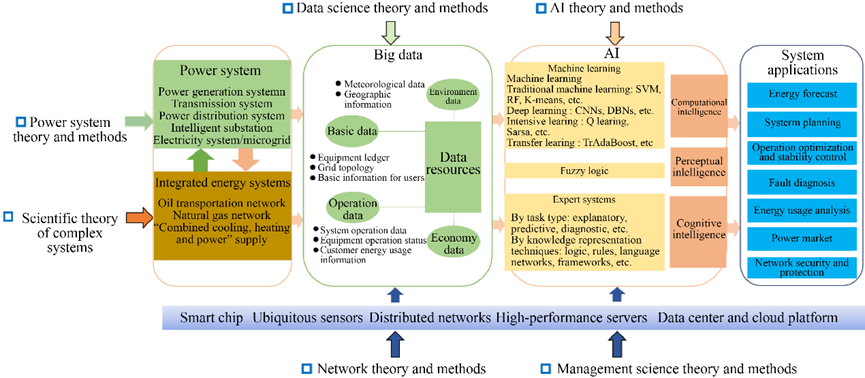
Fig. 3. Relationship between power system, integrated energy system, big data, AI, and system application requirements.
4.2.6 Management Science Theory and Methods
Management science theories and methods aim to enhance the comprehensive management capabilities of grid enterprises. They primarily involve operations research, production planning and management, decision analysis, behavioral science, and computer simulation [13]. For example, mathematical optimization theory, represented by operations research, is used to study the characteristics of management objects and their operation laws and to abstract a high-confidence mathematical model whereby a comprehensive analysis is performed based on sufficient information. This is strongly related to the transparent and unhindered flow of information in a transparent power grid [14].
《5 Key technologies and basic equipment of the transparent power grid》
5 Key technologies and basic equipment of the transparent power grid
《5.1 Key Technologies of the transparent power grid》
5.1 Key Technologies of the transparent power grid
The transparent grid technology system mainly includes key technologies on the perception, network, platform, and application layers, as shown in Fig. 4.
5.1.1 Perception layer key technologies
The perception layer aims to provide information collection services for constructing and operating transparent power grids. The key lies in building an intelligent integrated system of IoT devices composed of multi-parametric smart micro and nano sensors [15]. Multi-parametric sensors are overlaid with multi-channel and other technologies for multi-parametric acquisition to improve information transparency and reliability, enhance information value, extend the sensing cycle, and reduce deployment and maintenance costs. Smart micro-nano sensors are supported by over-nanometer process chips and nanomaterial technologies to reduce the sensors’ size, improve the versatility and space utilization of sensing scenarios, enhance the self-maintenance and self-learning capabilities of sensing terminals, and participate in intelligent feedback and assisted decision-making.
5.1.2 Network layer key technologies
We need to break through the technologies of extensive laying and connection stability of network infrastructure, communication transmission security [16], and high-speed information transmission to meet the requirements of wide coverage, high reliability, and low latency communication networks. To build a sensing data communication network, we need to integrate the key technologies involved in network planning, design, and maintenance, such as communication standards and protocols, network security protection, and data transmission guarantee. We also need to guarantee the quantity and quality of data access, protect the privacy and security of data, improve the application scope and application efficiency of information to increase the value of data application, reduce the potential risks in the process of information transmission, and reduce data loss.
《Fig. 4》
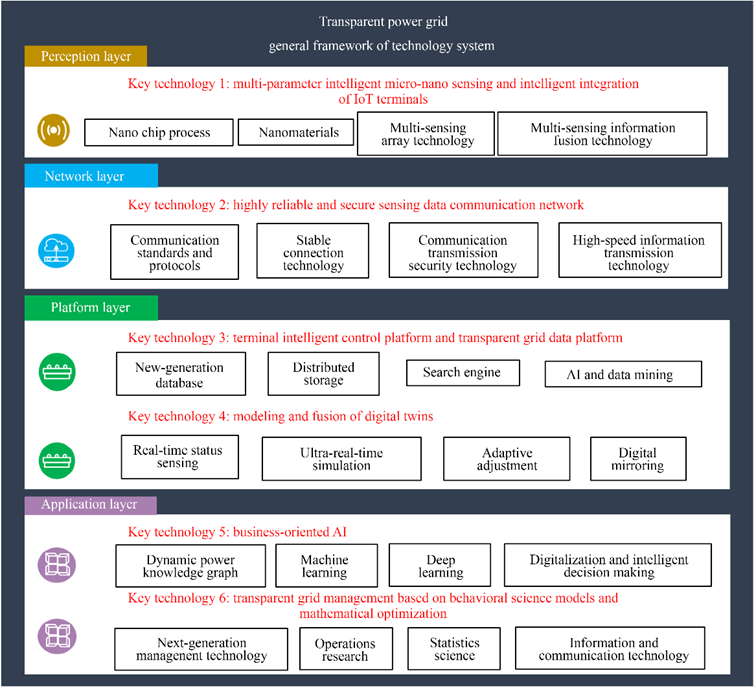
Fig. 4. General frameworks of the transparent grid technology system.
5.1.3 Platform layer key technologies
The first aspect is the terminal intelligent control platform and the key technology of the transparent grid platform. Smart terminals provide sensing functions and aim to provide target information to assist in decision-making, and thus need to be controlled by the transparent grid. The intelligent control platform considers the constraints of the terminal working environment and real-time demand of the grid and uses AI and other technologies to control the operational status of many intelligent terminals [17]. Smart terminals provide interfaces to massive multi-source heterogeneous data, and the obtained big data is an essential asset for transparent power grids. Using technologies such as new-generation databases and distributed storage [18], data are efficiently organized, stored, and processed. Using technologies such as retrieval engines, the required data are quickly obtained to accelerate the subsequent development process. In addition, the data platform derives applications such as data analysis and data mining, which not only support the development of transparent power grid business but also provide feedback on the whole process of data collection and processing.
The second aspect is the digital twin modeling and fusion key technology. The digital twin model is derived from the compressed real physical system, and it screens the salient features and reconstructs the corresponding digital model. Different feature compression methods should be studied for the characteristics of each link of the transparent grid, and the optimal method should be selected to construct the virtual model. The digital twin uses real-time data and historical data resources, synchronizes the digital model with the physical system, and creates a dynamic virtual digital model through real-time state sensing and ultra-real-time simulation [19,20]. The digital twin platform is built to form a digital mirror that can be disassembled, transferred, modified, and repeatedly operated, which can assist operators in understanding the physical entities of the power grid deeply. It is also possible to conduct current state assessments, historical diagnostics, and future projections, with good simulations of possibilities to support comprehensive decision-making.
5.1.4 Application layer key technologies
The first aspect comprises the business-oriented AI key technologies. For the intelligent and rapid response needs of transparent power grid business, the business-oriented AI key technology [21], which means the dynamic power knowledge graph combined with AI technology, can solve problems systematically. The power knowledge graph is based on graph data structure to form a relationship network with the comprehensive knowledge, business data, industry norms, industry standards, relevant processes, and other information of each power business object. As the business unfolds and data increases, the power knowledge graph continuously evolves adaptively and forms a dynamic knowledge graph. Represented by machine learning and deep learning, AI technology learns the representation of data and deeply mines and interprets the dynamic electricity knowledge map. It selects information relationships as the entry point to fully realize the integration, analysis, and judgment of knowledge features.
The second aspect is the key technology of transparent power grid management based on behavioral science and mathematical optimization. Behavioral science and mathematical optimization theories are used to establish data-driven mathematical management models, which can pursue efficient management and create value for management [22]. The multi-parametric small and micro sensors in the transparent power grid perception layer provide the basic conditions for power grid data collection and further broaden the application scenarios of sensors in the traditional sense. Mathematical optimization theories, such as operations research and statistics, are applied to seek the optimal solution of the mathematical management model of the transparent power grid. The organic combination of mathematical optimization, behavioral science models, and ICT improves the processing capability of practical management problems and enhances the scientific basis and reliability of decision-making.
《5.2 Basic equipment of the transparent power grid》
5.2 Basic equipment of the transparent power grid
China’s power equipment enterprises, including the Digital Power Grid Research Institute of China Southern Power Grid Corporation, are actively developing intelligent power infrastructure equipment to build a solid foundation for transparent power grid construction and operation. (1) In terms of the paste-type miniature smart current sensor, two types, snap and hoop, as shown in Fig. 5, have been put into industrial production. (2) In terms of miniature smart voltage sensors, a voltage measurement method based on a displacement current/distribution capacitance divider combined with a standard signal source has been developed, as shown in Fig. 6. (3) The “five-in-one” intelligent electrical measurement integrated sensor consists of integrated voltage, current, frequency, power angle, and other electrical measurement and timing functions, as shown in Fig. 7. (4) In terms of intelligent transformers, micro and nano smart robots (sensors) are implanted inside the transformer, which can automatically inspect the transformer oil, internal insulation, and other states to achieve data acquisition and accurate prediction of the transformer’s internal state, as shown in Fig. 8. (5) In terms of transparent transmission lines, smart sensors are arranged on transmission lines and towers to achieve complete status monitoring and present line status in real-time, as shown in Fig. 9. (6) In terms of chip-based protection, we have successfully developed 110 kV / 220 kV / 500 kV chip-based protection devices and realized unprotected installation of the devices, as shown in Fig. 10.
《Fig. 5》


(a) Snap type (b) Hoop type
Fig. 5. Miniature smart current sensor.
《Fig. 6》
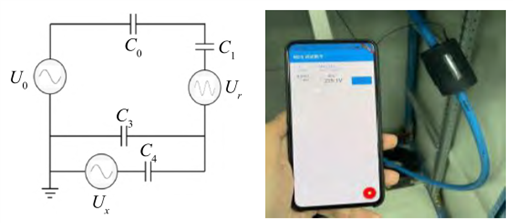
(a) Equivalent circuit (b) Prototype testing
Fig. 6. Miniature smart voltage sensor.
Note: U0 indicates the voltage to be measured; Ur indicates the voltage of the standard signal source connected in series inside the sensor; Ux indicates the voltage of the adjacent conductor; C0 indicates the capacitance between the conductor in the cable to be measured and the sensor; C1 indicates the voltage dividing capacitance connected in series; C3 indicates the distributed capacitance of the sensor housing to the ground; C4 is the distributed capacitance of the housing to the adjacent conductor.
《Fig. 7》

Fig. 7. “Five-in-one” smart electrical volume integrated sensor.
《Fig. 8》

Fig. 8. Smart transformer.
《Fig. 9》
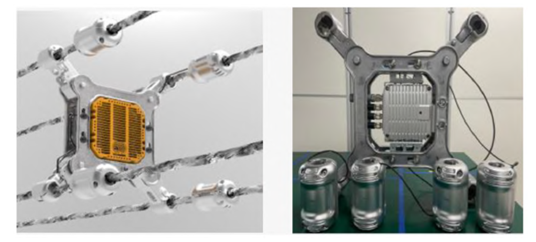
Fig. 9. Transparent transmission line.
《Fig. 10》
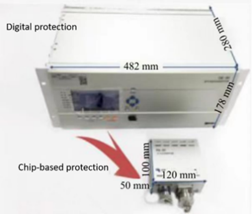

(a) Protection device size (b) Chip function schematic
Fig. 10. Chip-based protection device.
Note: GOOSE indicates generic object-oriented substation event; MMS indicates manufacturing message specification; MAC indicates medium access control; SV indicates sampling value.
《6 Suggestions for transparent power grid development》
6 Suggestions for transparent power grid development
《6.1 Promoting low-carbon energy transformation and building a safe and efficient modern energy system by strengthening new infrastructure of the transparent power grid》
6.1 Promoting low-carbon energy transformation and building a safe and efficient modern energy system by strengthening new infrastructure of the transparent power grid
The transparent power grid is based on the modern power and energy network and new generation ICT, involving small and micro intelligent sensors in different dimensions (point, line, and surface) combined with IoT terminals, communication networks, industrial software, big data, AI, cloud computing, and other technologies. It is connected “from the surface to the inside” to achieve the visibility, knowledge, and control of the power grid. It involves time, space, business, and other industry chain value dimensions for panoramic display, intelligent operation, flexible regulation, and convenient application.
Through the development and application of a full range of small and micro intelligent sensors, intelligent equipment, industrial software, data networks, and other technologies, transparent power grids can well integrate the business and management of energy and power enterprises to form a new energy ecology and fully support energy production, transmission and distribution, electricity consumption, and emerging integrated energy services.
The new energy ecosystem around the transparent grid applies the Internet concept, big data, cloud computing, IoT, mobile Internet, AI, blockchain, and other advanced technologies to integrate and innovate the existing scattered systems and platforms; strengthen the power supply, grid, load, and sensing and control of energy storage chains; and break the business barriers of operation control and operation management. Therefore, the ecosystem can firmly grasp the massive end-users and their operation data. In the process, it realizes the transparent control of energy, business, and data flows and optimally allocates resources, thus forming a big power grid energy ecosystem driven by the power market.
《6.2 Conducting particular scientific and technological research to establish key technology and equipment systems for the transparent power grid》
6.2 Conducting particular scientific and technological research to establish key technology and equipment systems for the transparent power grid
China should implement a particular science and technology project for small and smart sensors to achieve the design, manufacturing, and application of small and smart sensors in a systematic manner. It is necessary to gradually implement cross-research in basic science, upgrade the entire industry chain of precision instrument manufacturing, and polish and optimize the application scenarios of sensors. Research will be conducted on nanodevices, multi-channel/multi-reference acquisition, multi-sensing information fusion, and other technologies to solve the sensor miniaturization and multi-functional integration problems and improve the applicability of multiple scenarios to overcome the sensing energy extraction technology. There will be research for the development of new intelligent chips, with self-powered, self-maintained, and self-learning capabilities of the sensor to achieve multi-mode fusion power supply, “stick-and-use,” and other technological leaps.
It is recommended to implement certain software system science and technology projects that merge with the national industrial Internet and focus on resolving the technical bottlenecks of large industrial software architecture design, development automation, operation, and maintenance management to provide full automation and intelligent capability support for transparent power grids. This research will be based on technologies, such as big data, cloud computing, IoT, mobile Internet, AI, and blockchain for building fundamental technology platforms, such as cloud platform, big data platform, IoT platform, and AI platform. It will focus on developing digital modeling, ultra-real-time simulation, and twin co-information technologies for physical power grids to fulfill the needs of complex space–time constraints and transparent power grid practical application requirements.
It is recommended to research the transparent power grid smart equipment science and technology, focusing on breakthroughs in power electronics, intelligent materials, intelligent terminals, small and micro intelligent sensors, and other key technologies. This will be achieved through the use of massive data and the overall knowledge of the power grid hardware system to ensure the safe, reliable, and economic operation of the energy power system.
It is proposed to implement special projects on data-driven technology for value-added electric power services, focusing on solving industry development problems, such as whole-life cycle management and value mining of data. These projects will focus on improving the value density from the massive application of data, generating algorithm designs of multi-source heterogeneous data, big data mining, and other capabilities. Thus, platforms will be built for energy system management, customer service, dispatch operation, and enterprise control, integrating the internal and external elements of the power grid business. Therefore, an operation system will be formed with core competitiveness for supporting the efficient implementation of transparent power grid business.
《Compliance with ethics guidelines》
Compliance with ethics guidelines
The authors declare that they have no conflict of interest or financial conflicts to disclose.

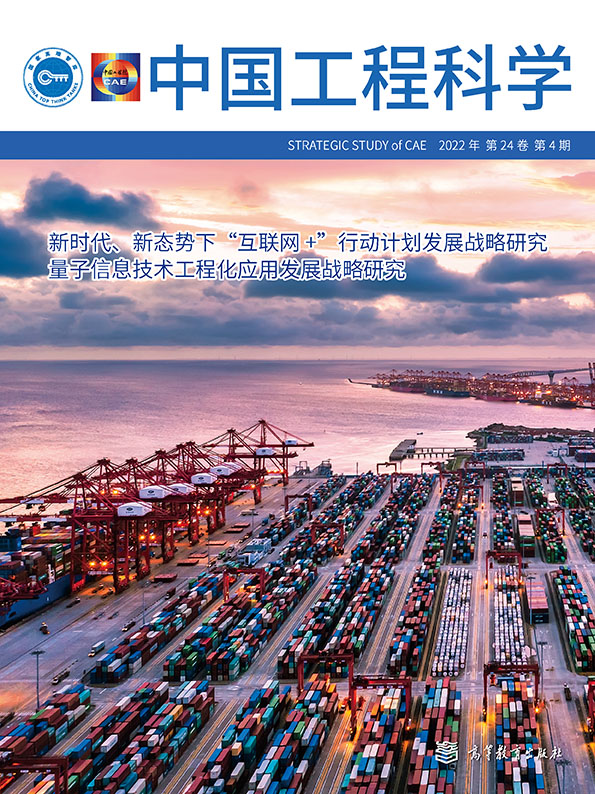











 京公网安备 11010502051620号
京公网安备 11010502051620号




